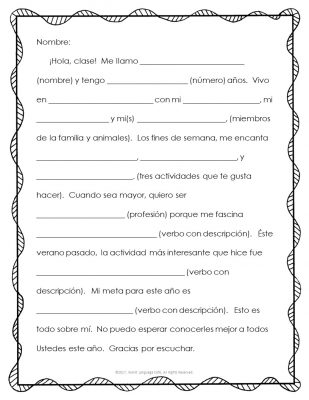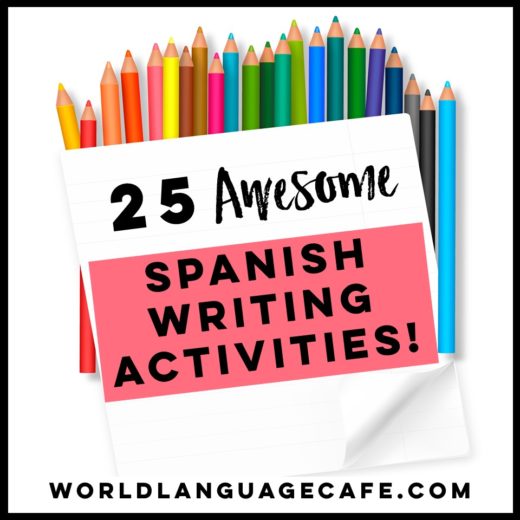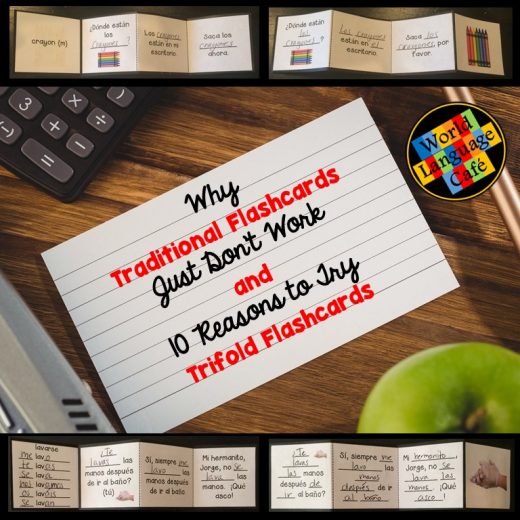Are you struggling to teach Spanish writing to your students?
If your Spanish students are writing short, choppy first-grade level sentences, try using Spanish writing templates to dramatically improve and formalize their writing.
If this is happening in your class, you’re not alone. Many students struggle to write in English so when you ask them to write in another language, it gets pretty messy.
In this series of posts, I’ll share my best tips and tricks for teaching writing in your Spanish classes.
Before I get started, just a few thoughts on writing in general . . .
Raising my kids bilingually has dramatically changed my thinking about the importance of Spanish writing skills. Here are a few things to think about . . .
How often will our students need to write paragraphs and compositions in Spanish in the real world?
Writing in another language is a technical skill that students may need if they take a job that requires Spanish skills or decide to live in another country for an extended period of time. However, the majority of our students will not be doing this.
When kids learn native languages, they aren’t expected to write until they’ve been speaking and listening for 5 years.
This is partially because they don’t have the hand-eye coordination to write yet, but also, it just makes sense. Why are we asking students to write when they don’t know how to say what they want to say?
Writing, editing, and rewriting take a considerable amount of time.
Wouldn’t that time be better spent learning to communicate effectively before students are expected to produce with written fluency?
Limit Large Writing Tasks
For these reasons, I actually recommend limiting large writing tasks in lower-level Spanish classes. Instead, focus on the key skills of listening, speaking, and reading until students reach a certain level of mastery.
In some schools, this is difficult because they want to see written work from students and you have to do what your co-workers are doing. It might be worth having this type of conversation with your Department Head or with your colleagues to see if you can change the focus to more communication.
Use Templates
When you do have to assess writing at lower levels, give Spanish writing templates and examples to show your students models of what you expect. After all, what is the point of having students struggle to write something and be doing it the wrong way?
If you ask students to write without Spanish writing templates or examples, they:
A. Get frustrated because it’s such a struggle to write and have a negative language experience.
B. Feel even worse when they get a paperback with tons of corrections
C. Are confused as to what they need to correct and how to do it.
Wouldn’t it be better to show them how to write and then have them produce work that is grammatically correct? That way, they’re practicing accurate grammar and will feel more successful. The act of writing will reinforce how to form sentences correctly.
Here’s an example of how my thinking has changed:
Before:
At the beginning of the year, I used to ask my Spanish 2 students to do presentations about themselves and then to write these up as compositions.
What I got back was pretty much a mess and I spent hours grading these with correction symbols and then having students edit and rewrite them. However, even after all that, they still continued to make similar mistakes throughout the year.
After:
I created a fill-in-the-blank template for this type of Spanish composition. Now students have the basis to write a much better composition and while doing so, are learning how to write correctly.
They fill in the blanks and then write out the whole composition on the computer or by hand. I prefer having them write by hand because the hand-brain connection helps students remember more.

All about Me Spanish Writing Project
Get free copies of these All about Me Spanish Writing Projects in my Free Resource Library (plus tons of other great stuff).
These are the types of writing activities that I choose to do now with my lower-level Spanish students. Less frustration for them + no more hours of grading for me + better learning experience = everybody wins!
Want more ideas for teaching writing in Spanish to your students? Then, check out the other writing posts in this series, “25 Spanish Writing Activities and Spanish Projects” and “Using Spanish Transition Words to Improve Student Writing“.
Grab these ready-made helpful writing resources:
101 Spanish Transition Words
Spanish Fairy Tale Project
Happy Teaching!
~Sherry






5 Comments
alice shrader
November 24, 2020 at 1:21 pmIm in a loop and cannot find any concrete template for teaching writing in Spanish 1. I see you mention it and explain it, which is great. I fully hoped to find an actual resource. Am I missing something?
Sherry Sebesta
November 24, 2020 at 1:58 pmDid you sign up for the Free Resource Library? Once you’re signed up and in the library there is a Todo sobre mí project. Email me at: worldlanguagecafe@gmail.com if you have questions.
alice shrader
November 24, 2020 at 1:22 pmAlso, in reference to your comment ‘ How often will they need to write in the real world?” , a LOT if they go on to advanced classes. They will be writing in college, They will write in AP/IB and I’ve taught all of these. They need to know how to write. It is essential.
Sherry Sebesta
November 24, 2020 at 1:56 pmHi Alice – yes, I agree that they will need to write in school and in classes, but I was talking about in the real world after school. Much more important to be able to communicate with the people that they meet. Most likely, they will only use their writing skills if they get a job involving Spanish. However, of course, I teach them to write well in my classes, too. 🙂
T
March 13, 2022 at 9:25 pmAfter college, my son took an internship with a congressman and unexpectedly ended up writing copy for Mexican newspapers. One never knows! That was a few years ago. These days, online translation services continue to make strides.